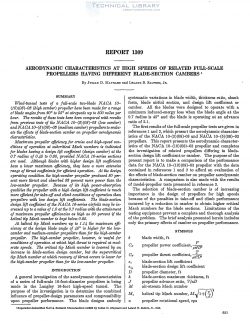naca-report-1309
- Version
- 211 Downloads
- 1.34 MB File Size
- 1 File Count
- November 2, 2016 Create Date
- November 2, 2016 Last Updated
National Advisory Committee for Aeronautics, Report - Aerodynamic Characteristics at High Speeds of Related Full Scale Propellers Having Different Blade Section Cambers

A general investigation of the aerodynamic characteristics
of a series of full-scale 10-foot-diameter propellers is being
made in the Langley 16-foot high-speed tunnel. The
purpose of the investigation is to determine the combined
influence of propeller-design parameters and compressibility
upon propeller performance. The blade designs embody
systematic variations in blade width, thickness ratio, shank
form, blade airfoil section, and design lift coefficient or
camber.
The first results of the full-scale propeller tests are given in
references 1 and 2, which present the aerodynamic character—
istics of the NACA 10-(3)(08)-03 and NACA 10—(5) (08)-03
propellers. This report presents the aerodynamic character-
istics of the NACA 10—(10)(08)—03 propeller and completes
the investigation of related propellers differing in blade-
section design lift coeflicient or camber. The purpose of the
present report is to make a comparison of the performance
data for the NACA 10—(10)(08)—03 propeller with the data
contained in references 1 and 2 to afford an evaluation of
the effects of blade-section camber on propeller aerodynamic
characteristics. A comparison is also made with the results
of model—propeller tests presented in reference 3.
The selection of blade-section camber is of increasing
importance in the design of propellers for high speeds
because of the penalties in take-01f and climb performance
incurred by a reduction in camber to .obtain higher critical
Mach numbers for the blade sections. Limitations of the
testing equipment prevent a complete and thorough analysis
of the problem. The brief analysis presented herein includes
only the primary effects of camber on propeller performance.
The high-camber propeller, however, is useful for
conditions of operation at which high thrust is required at mod-
erate speeds. The critical tip Mach number is lowered by an
increase in blade-section design camber, but the supercrz'tical
tip .Mach number at which recovery of thrust occurs is lower for
the high-camber propeller than for the low—camber propeller.
| File | Action |
|---|---|
| naca-report-1309 Aerodynamic Characteristics at High Speeds of Related Full Scale Propellers Having Different Blade Section Cambers.pdf | Download |

Comment On This Post